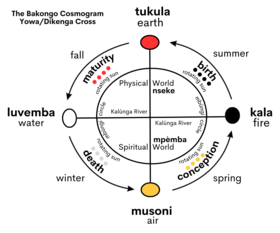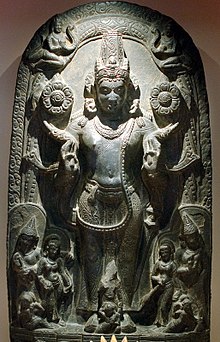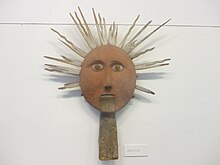A solar deity is a god or goddess who represents the Sun, or an aspect of it, usually by its perceived power and strength. Solar deities and Sun worship can be found throughout most of recorded history in various forms. The following is a list of solar deities:
African

Bakongo mythology
- Nzambi Mpungu, Kongo god of the Sun and creation
Bantu mythology
Berber/Amazigh mythology
Igbo mythology
Dahomey mythology
Egyptian mythology
- Amun, creator deity sometimes identified as a Sun god
- Aten, god of the Sun, the visible disc of the Sun
- Atum, the "finisher of the world" who represents the Sun as it sets
- Bast, cat goddess associated with the Sun
- Hathor, mother of Horus and Ra and goddess of the Sun
- Horus, god of the sky whose right eye was considered to be the Sun and his left the Moon
- Khepri, god of the rising Sun, creation and renewal of life
- Ptah, god of craftsmanship, the arts, and fertility, sometimes said to represent the Sun at night
- Ra, god of the Sun
- Sekhmet, goddess of war and of the Sun, sometimes also plagues and creator of the desert
- Sopdu, god of war and the scorching heat of the summer Sun
Nubian mythology
- Apedemak, the Meroitic god of war and sometimes depicted as the god the Sun
Zulu mythology
- uMvelinqangi, Xhosa and Zulu people's god of the Sun and sky
- iNyanga, Zulu people, goddess of the Moon
- Ukhulukhulwana, Zulu people's ancestor who came from the stars. He taught them to build huts and taught them the high laws of isiNtu
American
Aztec mythology
- Huitzilopochtli, god of the Sun and war
- Nanahuatzin, god of the Sun
- Teoyaomicqui, god of lost souls, the Sun, and the sixth hour of the day
- Tonatiuh, god of the Sun and ruler of the heavens
Brazilian mythology
- Guaraci, god of the Sun (Guarani mythology)
- Meri, folk hero and god of the Sun
Inca mythology
- Apu Inti, also known as Apu Punchaw, god of the Sun and patron deity of the Inca Empire
- Ch'aska ("Venus") or Ch'aska Quyllur ("Morning star") was the goddess of dawn, twilight, youth, and, the planet itself
Mapuche mythology
Inuit mythology
- Akycha, Sun goddess worshiped in Alaska
- Siqiniq, goddess of the Sun found across Greenland, northern Canada, and Alaska.
Maya mythology
- Ah Kin, god of the Sun, bringer of doubt, and protector against the evils associated with darkness
- Hunahpu, one of the Maya Hero Twins; he transformed into the Sun while his brother transformed into the Moon
- Kinich Ahau, god of the Sun
Muisca mythology
Other American Indian mythology
- Aqalax, Kathlamet sun woman.
- Jóhonaaʼéí, the Navajo Sun god, known as "The One Who Rules the Day"
- Kisosen, the Abenaki solar deity, an eagle whose wings opened to create the day and closed to cause the nighttime
- Napioa, the Blackfoot deity of the Sun
- Tawa, the Hopi creator and god of the Sun
- Wi, Lakota god of the Sun
- Aba' Bínni'li', the Chickasaw creator deity, strongly associated with the sun.
- Unelanuhi, Cherokee sun goddess.
Asian
Ainu mythology
- Chup Kamui, a lunar goddess who switched places with her brother to become goddess of the Sun
Arabian mythology
- Malakbel, god of the Sun
- Shams/Shamsun, a solar goddess exalted in Himyar and by the Sabaeans.
Armenian mythology
- Ar/Arev, the Sun god with its people as "children of the Sun"
Buddhist mythology
- Marici, goddess of the heavens, the Sun, and light
- Surya, god of the Sun (Suriya Pariththa, Suthra Pitaka, Pali canon, Theravada Buddhism)
Canaanite mythology
- Shapash, goddess of the Sun
- Ba'al, god of life and fertility, also associated with the Sun and storms
Chinese mythology

- Doumu, Sun goddess sometimes conflated with Marici.
- Xihe, Sun goddess and mother of the ten suns
- Yu Yi, god that carries the Sun across the sky
- Xu Kai, god of the Sun star
Elamite
- Nahundi, god of the Sun and law
Filipino mythology
Main article: List of Philippine mythological figures- Init-init: the Itneg god of the Sun married to the mortal Aponibolinayen; during the day, he leaves his house to shine light on the world
- Chal-chal: the Bontok god of the Sun whose son's head was cut off by Kabigat; aided the god Lumawig in finding a spouse
- Mapatar: the Ifugao sun deity of the sky in charge of daylight
- Sun God: the Ibaloi deity who pushed up the skyworld and pushed down the underworld, creating earth, after he was hit by a man's arrow during the war between the peoples of the skyworld and the underworld
- Elag: the Bugkalot deity of the Sun, worshiped with the moon and stars; has a magnificent house in the sky realm called Gacay; retreats to his home during nights; giver of light and growth
- Apo Init: the Ilocano deity of the sun
- Amman: the Ilocano god of the Sun, where the sun is his eye
- Agueo: the morose and taciturn Pangasinense sun god who is obedient to his father, Ama; lives in a palace of light
- Algao: the Aeta Sun god who battled the giant turtle Bacobaco
- Mangetchay: also called Mangatia; the Kapampangan supreme deity who created life on earth in remembrance of his dead daughter; lives in the Sun; in other versions, she is the creator and net-weaver of the heavens
- Aring Sinukûan: the Kapampangan Sun god of war and death, taught the early inhabitants the industry of metallurgy, wood cutting, rice culture and even waging war; lives in Mount Arayat, and later included a female form
- Apolaki: the Tagalog god of sun and warriors; son of Anagolay and Dumakulem; sometimes referred as son of Bathala and brother of Mayari; ruler of the world during daytime
- Quadruple Deities: the four childless naked Tau-buid Mangyan deities, composed of two gods who come from the Sun and two goddesses who come from the upper part of the river; summoned using the paragayan or diolang plates
- Adlao: the Bicolano son of Dagat and Paros; joined Daga's rebellion and died; his body became the sun; in another myth, he was alive and during a battle, he cut one of Bulan's arm and hit Bulan's eyes, where the arm was flattened and became the earth, while Bulan's tears became the rivers and seas
- Unnamed God: a Bicolano Sun god who fell in love with the mortal, Rosa; refused to light the world until his father consented to their marriage; he afterwards visited Rosa, but forgetting to remove his powers over fire, he accidentally burned Rosa's whole village until nothing but hot springs remained
- Sanghid: the Waray giant who wove cloth on a gold loom with supernatural speed; has the power to move back the Sun
- Liadlao: the gold-bodied Bisaya son of Lidagat and Lihangin; killed by Kaptan's rage during the great revolt; his body became the Sun
- Adlaw: the Bisaya Sun deity worshiped by the good
- Launsina: the Capiznon goddess of the Sun, Moon, stars, and seas, and the most beloved because people seek forgiveness from her
- Magrakad: the Tagbanwa god found at exactly noontime on the other side of the Sun; gives the warmth which sustains life and, when the people are ill, carries away sickness
- Tumangkuyun: wash and keep clean the trunks of the two sacred cardinal trees in Sidpan and Babatan by using the blood of those who have died in epidemics; the blood he uses causes the colors of the sunrise and sunset
- Libtakan: the Manobo god of sunrise, sunset, and good weather
- Unnamed Gods: the Bagobo gods whose fire create smoke that becomes the white clouds, while the Sun creates yellow clouds that make the colors of the rainbow
- Kadaw La Sambad: one of the two T'boli supreme deities; married to Bulon La Mogoaw; lives in the seventh layer of the universe
- Lageay Lengkuos: the greatest of Teduray heroes and a shaman (beliyan) who made the earth and forests; the only one who could pass the magnet stone in the straight between the big and little oceans; inverted the directions where east became west, inverted the path of the Sun, and made the water into land and land into water
- Sun Deity: the divine Maranao being depicted in an anthropomorphic form as a flaming young man; angels serve as his charioteers
Hindu mythology

- Surya, the Sun god, rides across the sky in a horse-drawn chariot à la Helios and Sol.
- Aruna, charioteer of Surya, god of the morning Sun.
- Aryaman, god of the midday Sun.
- Savitr, god of the twilight Sun, also known as sunrise and sunset.
- Mitra, often associated with the Sun.
- Mihir, meaning Sun.
- Tapati, Sun goddess.
Hittite mythology
- Istanu, goddess/god of the Sun and judgment
- Sun goddess of Arinna
- Sun god of Heaven, daylight god of judgement
- Sun goddess of the Earth, infernal goddess of the underworld.
Japanese mythology

- Amaterasu, goddess of the Sun
Mesopotamian mythology
- Shamash, Akkadian god of the Sun and justice
- Utu, Sumerian god of the Sun and justice
- Šerida, Sumerian goddess of light, married to the god of the Sun (Akkadian name Aya)
Scythian religion
- Tabiti, ancient Iranian goddess possibly connected with the Sun.
Tocharian
- A "sun deity" (kaum näkte), possibly a goddess.
Turkic mythology
- Gun Ana, common Turkic solar deity, seen as a goddess in the Kazakh and Kyrgyz traditions
- Koyash, god of the Sun
Persian mythology
- Mithra, often associated with the Sun.
- Hvare-khshaeta, the Sun yazata
Zunism
- The Zunbil dynasty and the subjects of Zabulistan worshiped the Sun, which they called Zun. They believed that the Sun was the god of justice, the force of good in the world and, consequently, the being that drove out the darkness and allowed man to live another day.
Vietnamese mythology
- Goddess Thần Mặt Trời, the embodiment of the sun, the daughter of Ông Trời, old sister of Thần Mặt Trăng, she and her sister have a husband who is a bear, when the Bear God wants to meet them, a solar or lunar eclipse will appear.
European
Albanian mythology

- Dielli, the Sun, god of light, sky and weather, giver of life, health and energy, and all-seeing eye.
Armenian mythology

Baltic mythology
- Saulė, goddess of the Sun
Basque mythology
- Ekhi, goddess of the Sun and protector of humanity
Celtic mythology
- Áine, Irish goddess of love, summer, wealth, and sovereignty, associated with the Sun and midsummer
- Alaunus, Gaulish god of the Sun, healing, and prophecy
- Belenos, Gaulish god of the Sun
- Brighid, Irish sun goddess
- Étaín, Irish Sun goddess
- Grannus, god associated with spas, healing thermal and mineral springs, and the Sun
- Lugh, Sun god as well as a writing and warrior god
- Macha, "Sun of the womanfolk" and occasionally considered synonymous with Grian
- Olwen, female figure often constructed as originally the Welsh Sun goddess
- Sulis, British goddess whose name is related to the common Proto-Indo-European word for "Sun" and thus cognate with Helios, Sól, Sol, and Surya and who retains solar imagery, as well as a domain over healing and thermal springs. Probably the de facto solar deity of the Celts.
Etruscan mythology
Finnish mythology
- Päivätär, goddess of the Sun
Germanic mythology
- Sól/Sunna/Sunne, the common Sun goddess among the Germanic peoples, who according to Nordic mythology is chased across the sky in her horse-drawn chariot by a wolf
Greek mythology
- Helios, god and personification of the Sun who drives across the sky in a chariot
- Apollo, god of the Sun and light, among others. His most common epithet is Phoebus (“Radiant”)
- Eos, goddess and personification of the dawn
- Hemera, goddess of the day
- Electryone, goddess of the sunrise
Hungarian mythology
- Nap Király, the Hungarian god of sun who rides his silver fur horse everyday from east to west.
- Nap Anya, Goddess of the sun and partner of Nap király
Lusitanian mythology
- Endovelicus, god of health and safety, worshipped both as a solar deity and a chthonic one
- Neto, potentially both a solar and war deity
- A possible sun goddess, whose cult was believed to have become that of Virgin Mary Nossa Senhora de Antime.
Minoan mythology
- Possibly the Snake Goddess.
Proto-Indo-European mythology
Roman mythology
Sami mythology
- Beiwe, goddess of the Sun, spring, fertility, and sanity
Slavic mythology
Oceania
Australian Aboriginal mythology
- Bila, cannibal sun goddess of the Adnyamathanha
- Gnowee, solar goddess who searches daily for her lost son; the light of her torch is the Sun
- Wala, solar goddess
- Wuriupranili, solar goddess whose torch is the Sun
- Yhi, Karraur goddess of the sun, light and creation
Māori mythology
- Tama-nui-te-rā, personification of the Sun
See also
References
- Monaghan, Patricia (2010). Encyclopedia of Goddesses and Heroines. Santa Barbara, CA: Greenwood. ISBN 9780313349904.
- Monaghan, Patricia (2010). Encyclopedia of Goddesses and Heroines. Santa Barbara, CA: Greenwood. ISBN 9780313349904.
- J. F. Breton (Trans. Albert LaFarge), Arabia Felix From The Time Of The Queen Of Sheba, Eighth Century B.C. To First Century A.D., 1998, University of Notre Dame Press: Notre Dame (IN), pp. 119-120.
- Julian Baldick (1998). Black God. Syracuse University Press. p. 20. ISBN 0815605226.
- Merriam-Webster, Merriam-Webster's Encyclopedia of World Religions, 1999 - 1181 páginas
- J. Ryckmans, "South Arabia, Religion Of", in D. N. Freedman (Editor-in-Chief), The Anchor Bible Dictionary, 1992, Volume 6, op. cit., p. 172
- Cole, M. C. (1916). Philippine Folk Tales . Chicago: A.C. McClurg and Co.
- Jenks, A. (1905). The Bontoc Igorot. Manila: Bureau of Printing.
- Cawed, C. (1972). The Culture of the Bontoc Igorot. MCS Enterprises.
- Bimmolog, H., Sallong, L., Montemayor, L. (2005). The Deities of the Animistic Religion of Mayaoyao, Ifugao.
- Moss, C. R. (1924). Nabaloi Tales. University of California Publications in American Archaeology, 227–353.
- Wilson, L. L. (1947). Ilongot Life and Legends. Southeast Asia Institute.
- Llamzon, Teodoro A. 1978. Handbook of Philippine language groups. Quezon City, Philippines: Ateneo de Manila University Press.
- Alacacin, C. (1952). The Gods and Goddesses. Historical and Cultural Data of Provinces.
- Eugenio, D. L. (2007). Philippine Folk Literature: An Anthology. University of the Philippines Press.
- Beyer, H.O. (1915). Philippine Ethnographic Series.
- Jose, V. R. (1974). Creation and Flood Myths in Philippine Folk Literature. University of the Philippines.
- Nicdao, A. (1917). Pampangan Folklore. Manila.
- Nicdao, A. (1917). Pampangan Folklore. Manila.
- Aguilar, M. D. (2001). Women in Philippine Folktales. Holy Angel University
- Calderon, S. G. (1947). Mga alamat ng Pilipinas. Manila : M. Colcol & Co.
- ^ Jocano, F. L. (1969). Philippine Mythology. Quezon City: Capitol Publishing House Inc.
- Ramos, M. (1990). Philippine Myths, Legends, and Folktales. CreateSpace Independent Publishing Platform
- Kikuchi, Y. (1984). Mindoro Highlanders: The Life of the Swidden Agriculturists. New Day Publishers.
- Beyer, H. O. (1923). Ethnography of the Bikol People. vii.
- Arcilla, A. M. (1923). The Origin of Earth and of Man. Ethnography of the Bikol People, vii.
- Buenabora, N. P. (1975). Pag-aaral at Pagsalin sa Pilipino ng mga Kaalamang-Bayan ng Bikol at ang Kahalagahan ng mga Ito sa Pagtuturo ng Pilipino sa Bagong Lipunan. National Teacher's College.
- Hart D. V., Hart H. C. (1966). Maka-andog: A Reconstructed Myth from Eastern Samar, Philippines. The Journal of American Folklore.
- Miller, J. M. (1904). Philippine folklore stories. Boston, Ginn.
- Buyser, F. (1913). Mga Sugilanong Karaan.
- Cruz-Lucero, R., Pototanon, R. M. (2018). Capiznon. With contributions by E. Arsenio Manuel. In Our Islands, Our People: The Histories and Cultures of the Filipino Nation, edited by Cruz-Lucero, R.
- ^ Fox, R. B. (1982). Religion and Society Among the Tagbanuas of Palawan Island, Philippines. Manila: National Museum.
- Benedict, L. W. (1913). Bagobo Myths. Journal of American Folklore, pp. 26 (99): 13–63.
- Casal, G. (1978). The T'boli Creation Myth and Religion. T'boli Art: in its Socio-Cultural Context, pp. 122–123.
- Wood, G. L. (1957). Philippine Sociological Review Vol. 5, No. 2: The Tiruray. Philippine Sociological Society.
- Talaguit, C. J. N. (2019). Folk-Islam in Maranao Society. History Department, De La Salle University – Manila.
- The Problem of Tocharian Origins: An Archaeological Perspective
- The Spider’s Web. Goddesses of Light and Loom: Examining the Evidence for the Indo-European Origin of Two Ancient Chinese Deities
- "Nữ thần mặt trời và nữ thần mặt trăng - Thần thoại Việt Nam". TruyệnXưaTíchCũ. Retrieved 17 March 2023.
- "UM CULTO SOLAR OU RITUAL DE FECUNDIDADE". Archived from the original on 2011-12-30. Retrieved 2019-01-25.
- Enciclopédia das Festas Populares e Religiosas de Portugal. Vol. 1. Lulu.com. p. 64. ISBN 9789892013916.
- "TEÓFILO BRAGA. O POVO PORTUGUEZ NOS SEUS COSTUMES, CRENÇAS E TRADIÇÕES II". Lisboa, Livraria Ferreira. 1885.
- Ridderstad, Marianna (2009). "Evidence of Minoan Astronomy and Calendrical Practises". arXiv:0910.4801 .
- Marinatos, Nanno. Minoan Kingship and the Solar Goddess: A Near Eastern Koine (2013).
- O'Brien, Steven. "Dioscuric Elements in Celtic and Germanic Mythology". In: Journal of Indo-European Studies 10:1–2 (Spring–Summer, 1982), pp. 117–136.
- Meagher, Robert E. (2002). The Meaning of Helen: In Search of an Ancient Icon. Bolchazy-Carducci Publishers. pp. 46ff. ISBN 978-0-86516-510-6.
- West, Martin L. (2007). Indo-European Poetry and Myth. Oxford, England: Oxford University Press. ISBN 978-0-19-928075-9.
| Lists of mythological figures | |
|---|---|
| By geography |
|
| By association |
|